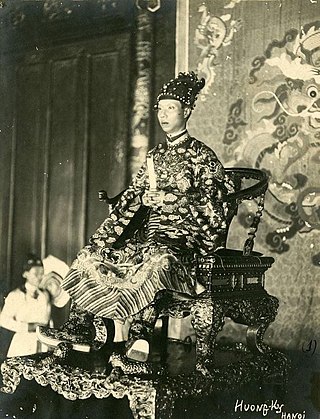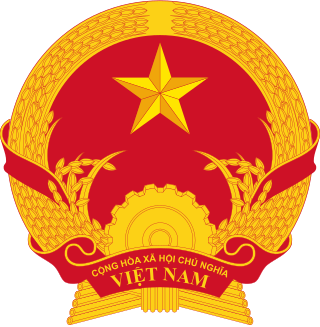
Bảo Đại, born Nguyễn Phúc (Phước) Vĩnh Thụy, was the 13th and final emperor of the Nguyễn dynasty, the last ruling dynasty of Vietnam. From 1926 to 1945, he was de jure emperor of Annam and Tonkin, which were then protectorates in French Indochina, covering the present-day central and northern Vietnam. Bảo Đại ascended the throne in 1932.

Khải Định was the 12th emperor of the Nguyễn dynasty in Vietnam, reigning from 1916 to 1925. His name at birth was Prince Nguyễn Phúc Bửu Đảo. He was the son of Emperor Đồng Khánh, but he did not succeed him immediately.

Đồng Khánh, born Nguyễn Phúc Ưng Kỷ (阮福膺祺) or Nguyễn Phúc Ưng Đường (阮福膺禟), also known as Chánh Mông (正蒙), was the ninth emperor of the Nguyễn dynasty of Vietnam. He reigned four years between 1885 and 1889. His royal temple name was Cảnh Tông (景宗).

Dục Đức, was Emperor of Vietnam for three days, from 20 to 23 July 1883. He was the fifth emperor of the Nguyễn dynasty and father of Emperor Thành Thái, who ruled from 1889 to 1907.

Tự Đức was the fourth and last pre-colonial emperor of the Nguyễn dynasty of Vietnam; he ruled from 1847 to 1883.

Văn Miếu, literally translated as Temple of Literature, is a temple dedicated to Confucius in Hanoi, northern Vietnam. The temple was founded and first built in 1070 at the time of Emperor Lý Thánh Tông, and it hosted the Imperial Academy, Vietnam's first national university, from 1076 to 1779. In 1803, The academy was moved to the new capital of Nguyen dynasty in Hue.

The National Emblem of the Socialist Republic of Vietnam or simply the emblem of Vietnam, has been one of the official national symbols representing the Socialist Republic of Vietnam since 1976. It is designed circular and based on the symbolism of the Vietnamese national flag, having a red background and a yellow star in the middle which represent the five main classes in Vietnamese society—intellectuals, farmers, workers, business people and military personnel; the revolutionary history and bright future of Vietnam. The cog and crops represent the cooperation of agriculture and industrial labor.

The Imperial City is a walled enclosure within the citadel of the city of Huế, the former imperial capital of Vietnam during the Nguyễn dynasty. It contains the palaces that housed the imperial family, as well as shrines, gardens, and villas for mandarins. Constructed in 1803 under Emperor Gia Long as a new capital, it mostly served a ceremonial function during the French colonial period. After the end of the monarchy in 1945, it suffered heavy damage and neglect during the Indochina Wars through the 1980s. The Imperial City was designated as a UNESCO World Heritage Site in 1993 as part of The Complex of Huế Monuments and is undergoing restoration.

The Imperial Citadel of Thăng Long is a complex of historic buildings associated with the history of Vietnam located in the centre of Hanoi, Vietnam. Its construction began in 1010 and was completed in early 1011 under the reign of Emperor Lý Thái Tổ of the Lý dynasty. Most of the existing structure is dated to the extensive reconstruction of the old Imperial Citadel ordered by Gia Long in 1805, but the Citadel was largely demolished by the French to allow more land for offices and barracks.
Vietnamese architecture is the architectural style used by the Vietnamese through the process of historical development and the absorption and integration of regional and international architectures. Vietnamese architecture is reflected in the works from đình, shrines, temples, nhà thờ họ, citadels, palaces and housing architecture.

Tomb of Tự Đức, officially Khiêm Mausoleum, is located in Huế, Vietnam. It is built for the Nguyễn Emperor Tự Đức and took three years to build, from 1864 to 1867. It is divided into a Temple Area and a Tomb Area.

Phạm Quỳnh was a monarchist during the late Nguyễn dynasty and supporter of adhering to traditional Vietnamese customs in the establishment of a constitutional monarchy. He was born near Hanoi, Vietnam, to a literati family of Hải Dương province. He was appointed Minister of Education to the royal court at Huế in 1932, and held several other posts in the court as premier and Minister of the Interior for Emperor Bảo Đại's government. He served as a government minister along with Ngô Đình Diệm under Emperor Bảo Đại's administration. After the August Revolution, he was killed by the Viet Minh along with two other high-ranking members of Bảo Đại's cabinet in September 1945.

The Tomb of Emperor Dục Đức, officially the An Mausoleum is a tomb complex in Huế, Vietnam, in which are buried Dục Đức and his wife, his son Thành Thái, his grandson the child-emperor Duy Tân, and several other members of Vietnam's last dynasty, the Nguyễn dynasty, such as the queen mother Nguyễn Thị Định.

The House of Nguyễn Phúc, also known as the House of Nguyễn Phước, is a family and a branch of the surname Nguyễn in Vietnam. Its members were the Nguyễn lords and emperors of the Nguyễn dynasty (1802-45). Its Bảo Đại was also emperor of the State of Vietnam (1949-55) and Domain of the Crown (1950-55). Nguyễn Bặc (924-79), an official of the Đinh dynasty, was its founder.

The Khải Định Thông Bảo was a French Indochinese sapèque coin produced from 1921 until 1933, the design of the coin was round with a square hole that was used for stringing them together. Khải Định became Emperor of Annam in 1916 the funding for the production of new cash coins was reduced by the Hanoi Mint which lead to the demand of the Vietnamese market for low value denominations to not be met, furthermore, after Hanoi reduced funding for the Thanh Hóa Mint, which until that time was producing enough low denomination cast cash coins to meet the market's demands, which caused most, but not all, of the production of cash coins at the mint to cease in 1920. In response a new committee was formed in Hanoi which ordered the creation of machine-struck Khải Định Thông Bảo cash coins, these are the first machine-struck four character Thông Bảo (通寳) coins in Vietnam with the reigning emperor's name as the French government had prior tried to introduce a Cochinchinese 2 sapèque coin that continued under French Indochina that weighed 2.05 grams and had a nominal value of 1⁄500 piastre, later the colonial government of the French Protectorate of Tonkin had unsuccessfully tried to introduce a zinc milled sapèque produced by the Paris Mint with a nominal value of 1⁄600 piastre from 1905 until 1906. Unlike the earlier attempts at producing machine-struck cash coins by the colonial French authorities the Khải Định Thông Bảo proved to be much more successful as the first series had a production of 27,629,000 coins while the second series greatly exceeded this with around 200,000,000 coins produced in Huế, Haiphong, and Hanoi. The Khải Định Thông Bảo continued to be produced long after the death of Emperor Khải Định under his successor Bảo Đại until it was phased out by the Bảo Đại Thông Bảo (保大通寳) in 1933.
Nguyễn Hữu Chỉnh was an official during the Revival Lê dynasty in Vietnam.

The seals of the Nguyễn dynasty can refer to a collection of seals specifically made for the emperors of the Nguyễn dynasty, who reigned over Vietnam between the years 1802 and 1945, or to seals produced during this period in Vietnamese history in general.

The abdication of Bảo Đại took place on 25 August 1945 and marked the end of the 143-year reign of the Nguyễn dynasty over Vietnam ending the Vietnamese monarchy. The fall of the Nguyễn dynasty also led to the fall of its Empire of Vietnam, de facto controlled by Japan. Emperor Bảo Đại abdicated in response to the August Revolution. A ceremony was held handing power over to the newly established Democratic Republic of Vietnam, which was established during the end of World War II in Asia as Vietnam had been occupied by French and later Japanese imperialists.

The coat of arms of the Nguyễn dynasty, officially the national coat of arms of Đại Nam, was the national coat of arms of the Nguyễn dynasty adopted during the reign of the Thành Thái Emperor to be used when accepting diplomatic missions and foreign dignitaries at the Imperial City of Huế.

Kien Trung Palace is a palace within the Imperial City of Huế, the former imperial capital of Vietnam. It was the residence of the last two emperors of the Nguyễn dynasty. It was destroyed by the Viet Minh in 1947 during the Indochina Wars. Reconstruction started in 2019 and was completed in 2023. The palace is now open to the public.






























